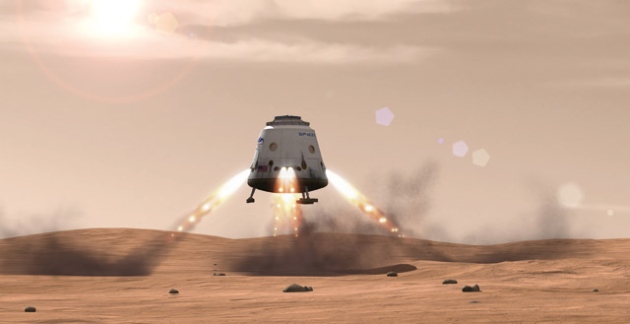SpaceX Dragon: To the ISS in 2011; On to Mars in 2018?
The 368-ton Falcon 9, a sleek, 180-foot aluminum lithium alloy rocket filled with liquid oxygen and kerosene, could launch from Cape Canaveral, Fla., as early as Dec. 19. Sitting in the rocket's nose will be an unmanned spacecraft named Dragon. After liftoff, Dragon will separate, attain orbit, conduct communications and maneuverability tests, and then—upon NASA approval—dock with the International Space Station. _World
Dragon is SpaceX' cargo and crew capsule, built to ride atop the Falcon 9 rocket. The Dragon is meant to serve for ISS re-supply missions, and a range of other missions for NASA and other customers. But SpaceX has its sights on the long term, including a possible Mars shot in 2018.
Dragon, the privately built space capsule intended to haul cargo and astronauts to the International Space Station (ISS), is auditioning for another high-profile role. Its maker, SpaceX of Hawthorne, California, says that the capsule, which is set to make its first test flight to the ISS later this month, could be dispatched to Mars — drastically cutting the cost of exploration on the red planet. Together with researchers at the NASA Ames Research Center in Moffett Field, California, the company is working on a proposal for a first 'Red Dragon' mission. _NatureMore from PopSci
SpaceX's approach is to convert the two stages of the Falcon 9 rocket into independent vehicles capable of making return landings at their launch site. The first stage, after separating from the rest of the rocket, would fire its engines to guide itself back to the launch site, extending a set of legs from its base to land vertically. The upper stage, outfitted with the heat shield that SpaceX developed for its Dragon spacecraft, which was designed to transport cargo and eventually crews to and from the space station, would reenter after deploying its payload in space. It would also use its engine for a powered vertical landing. _TechnologyReviewSpaceX is one of several private space companies being funded by billionaire-entrepreneurs, intent on pushing the future forward. SpaceX founder Elon Musk has been unrelenting in his support of the company and its ambitious goals.
Here is a chart listing some of Musk's fellow billionaire launchers of the future:
Opportunity societies such as the US once was, allowed large numbers of relatively young (mainly) men to achieve great wealth. Some of these young and young-at-heart men are devoting a considerable amount of their wealth to drive future-oriented enterprises such as access to outer space, advanced nuclear fission and fusion, and more. Peter Thiel, for example, is backing life extension, seasteads, and a number of other futuristic game changing technologies.We should also mention that the Google billionaires are putting up the Google Lunar X Prize, to motivate technology development for a return to the moon.
Jeff Bezos of Amazon.com has backed space launch company Blue Origin for years, and is now backing unconventional nuclear fusion startup General Fusion. Bill Gates' investment in Terrapower advanced fission reactors appears to reflect a deep commitment to advanced abundant energy.
A fair number of these billionare drivers of the future were also school dropouts. Perhaps there is something about having succeeded without receiving the official seal of approval from the educational establishment, which gives a person the courage to push ahead -- risking part of a huge fortune on ideas that are ever further out.
Billionaire Elon Musk's SpaceX is the frontrunner in the private space launch race, having successfully orbited its Falcon 9 boosted Dragon capsule. Robert Bigelow's Bigelow Aerospace is likewise the frontrunning developer of privately built space habitats. Both companies are bringing private sector performance values to the space enterprise which had been hampered by a government sector mentality up until recently.
Richard Branson's Virgin Galactic is the frontrunner for the exciting new industry of space tourism, due in large part to Branson's fortuitous partnership with pioneering aerospace engineer Burt Rutan. Billionaire Paul Allen also played an important role in that partnership. _Al Fin, the Next Level
It is quite possible that the first individual worth over a trillion dollars will derive his wealth from space commerce and resources. Elon Musk and the rest of the list -- and others yet to declare themselves -- are hoping to be that first trillionaire.
We at the Al Fin Blog Syndicate wish them luck.
Labels: Access to space, billionaire futurists, SpaceX




0 Comments:
Post a Comment
“During times of universal deceit, telling the truth becomes a revolutionary act” _George Orwell
<< Home